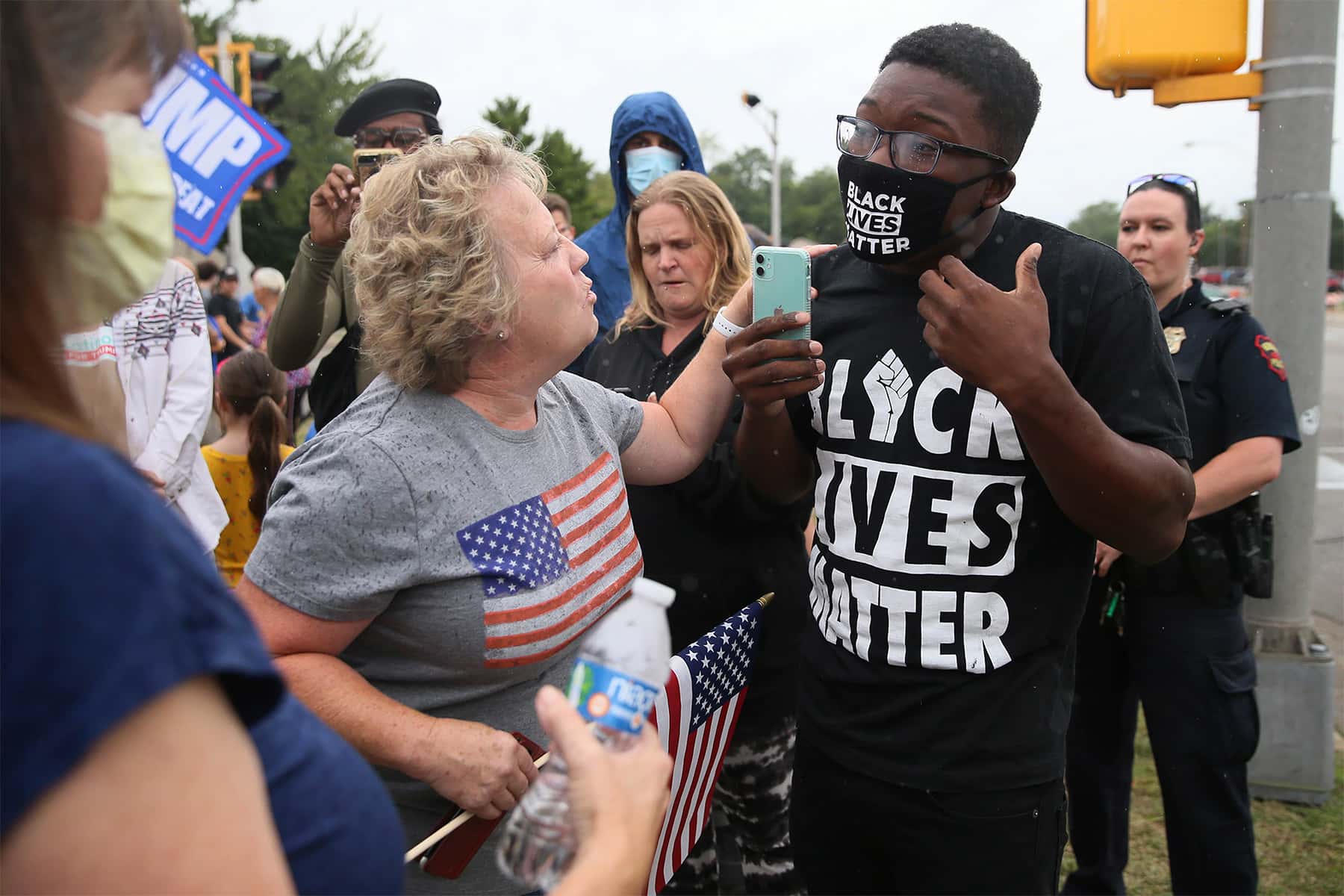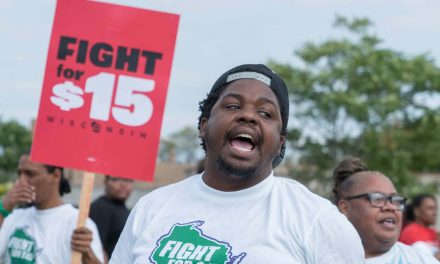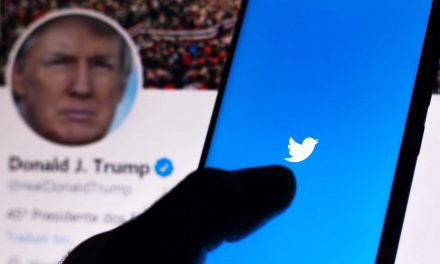
“I believe whites are not only “carefully taught” to hate, but they are also carefully conditioned to know the consequences if they don’t. The older that one is, the deeper this conditioning runs, and it’s based in part on a well-founded fear of physical harm.” – Kendra Hamilton, Blacks not only victims of racial discrimination
The first song Krista Hinman learned to play on the piano was Dixie, the de facto battle hymn of the Confederate States of America. She learned the minstrel-song-turned-slavery-anthem growing up in Southaven, Mississippi, a predominantly white suburb of Memphis, Tennessee.
“Everything I ever did was white,” Hinman, now 44 and a professional bartender, said on a southern-hot afternoon in the courtyard behind her apartment in Jackson, Mississippi’s majority-Black capital city.
The Ku Klux Klan, the white gang that rose again to terrorize Black residents during the civil rights movement, had mostly died down by the time of Hinman’s childhood – yet her neighbor in the 1970s had remained a member.
Was she racist herself?
“Oh yeah,” Hinman said. Born in 1974, she admits to regularly dropping the N-word and delighting in racist jokes with friends. “I was all in. I believed every single bit of it … all the ‘heritage’ stuff.”
She often regurgitated revisionist Civil War tropes long embedded in Southern textbooks: that Secession wasn’t over slavery; that the war was a glorious uprising against Federal tyranny; that slaves were happy and adored their masters until the Northern Yankees riled them up. She also defended the Confederate flag and monuments.
Hinman’s parents did not want racist jokes and the N-word inside their home. Still, while watching the TV show In the “Heat of the Night” when she was a kid, she quipped that she might bring home a Black boyfriend, angering her father.
Many White Southerners had adopted an uneven racial code since violent responses to civil rights gains in the 1960s. “He didn’t believe in total racism,” Hinman said of her father, “but you weren’t bringing [Black people] home.”
But in her 20s, while studying at the University of Mississippi, Hinman’s views changed. She made liberal friends. Her friend Kiki described growing up on the Black side of their wealthy college town, where Whites seldom ventured and children enjoyed fewer opportunities. Hinman came to believe that racism is not just interpersonal name-calling, but systemic denial of equity and equality – in education, the workplace, political representation, housing, healthcare and everyday life.
Hinman realized that many Whites are conditioned to believe lies that people of color were biologically inferior, more prone to crime, lazier. “It’s about a sense of superiority,” she said. “I might live in a trailer in Tchula, Mississippi, but at least somehow I can say I’m ‘better’ than these other people … We’ve done really horrible stuff to Black people in the name of superiority.”
Today, she has joined a growing chorus of Mississippians of wildly different backgrounds eager to talk about their racial miseducation in the hope to help bridge U.S. racial divides – and that requires unexpurgated truth. She now believes that the Mississippi flag and public Confederate statues memorialize oppression. “They all need to come down,” she said.
Historian Susan Glisson, 50, was pivotal to Mississippi’s public reckoning when she helped create a forum at the University of Mississippi in 1997 during then president Bill Clinton’s national race initiative. That effort morphed into the William Winter Institute for Racial Reconciliation, which designed “Welcome Table” dialogues around Mississippi between people of different races and beliefs.
“We don’t start talking about race,” said Glisson. “We start at the level of a human being to help people become self-reflective about who they are, their values. We build a bridge of trust.” Only then is it possible to contextualize 500 years of the history of racism and unpack systems that sustain White Supremacy long after slavery ended, she explains.
“It’s not a model based on blaming and shaming,” Glisson said of her approach. And White people – including progressives who think they have it figured out – need to show up and listen to make it happen. “It really should be White folks doing that work with White folks.”
Glisson applauded the public outing of White Supremacists who rioted in Charlottesville in 2017. “Them motherf*ckers lost their jobs,” she said approvingly, pointing to the active bystanderism often missing in earlier decades, with people filming racist events. But she still invited racists into circles without yelling and name-calling, which would not build relationships that facilitate education.
“We have to do both in a smart way,” she said, pointing to Hannah Arendt’s political friendships. It was basic math. She believed the more racists were redirected, the fewer people they could hurt directly or through harmful policies.
Bob Fuller, 56, was a middle school principal in nearby Starkville, Mississippi, when he had an epiphany. Two Black teachers there had the last name Coleman – the same name as his slave-owning ancestor. “My ancestors owned their ancestors,” the White academic thought to himself with horror.
Five generations of Fuller’s family had worked the land in rural Winston county in east central Mississippi, where he and his wife and children still live. Most were yeoman farmers and loggers, but the Coleman ancestors owned slaves.
“People in Iowa don’t have this dynamic,” he said, sitting on a leather sofa in a sprawling farmhouse he built on family land, surrounded by Mississippi history books, folk art and a string of small Tibetan flags. His wife, the Rev. Allison Stacey Parvin, is an ordained United Methodist elder and pastor of their nearby church.
“I grew up White Supremacist,” he admited. “We thought we were better than Black people.” When Fuller was in third grade, the U.S. supreme court forced recalcitrant public schools to integrate, but buses remained segregated for several years; his would pass Black kids waiting for a pickup. In his Mississippi history class in 1976, he heard no mention of the freedom fighters who had transformed the state a dozen years earlier. “We never discussed the civil rights movement.”
It took relationships with teachers and families of color to remake him. He soon threw off his blinders and faced the South’s full history of brutality.
“The Civil War really was over slavery; they tried to sugarcoat it,” he said, adding that it was a “rich man’s war, a poor man’s fight.” A year into the war, the Confederacy voted to allow men who owned 20 or more slaves to stay home.
“It’s the same thing today,” Fuller said, pointing to “a concerted effort” to keep working-class Black and White people separate politically despite common interests. “It’s called the Southern Strategy.”
Fuller is referring to a 1960s partisan realignment in which wealthy Republicans began using racist dog-whistling about Black crime and “welfare mothers” to push White Southerners to the right.
“They don’t want us to get together,” Fuller said of working-class Whites and Blacks.
As a principal, Fuller decided to quietly fly the U.S. instead of the state flag – which incorporated the Confederate battle – at his middle school. It was fine until a father, a Virginia native, noticed. “Why ain’t you flyin’ the Mississippi flag?” he asked Fuller. “Ain’t it the state law?”
The man reported Fuller to the district’s central office, which affirmed that the state flag had to go up. Fuller refused, and said district staff would have to hoist it daily, which they did.
Robert Brown faced Fuller, his arms crossed, from an identical sofa. Brown, who is Black, got to know Fuller’s wife, Parvin, after a tornado ripped through an African American part of Winston County in 2014, killing 10 and destroying many homes.
Brown, 44, is the son of a bootlegger, later adopted by a Black woman who raised him to want more. He now owns the Straight Line Barbershop, but regardless of his present success, Brown wishes he had gone to college.
Instead, he educated himself, especially on the state’s race history. Every chance he gets, he shares with White people what Confederate emblems represent to Black Americans. He protested against the state flag flying over a tornado memorial service where the governor spoke, then unsuccessfully tried to convince city hall to stop flying it on public property.
“I’ve been a rebel, a radical, all my life,” Brown said quietly. But Dylann Roof’s 2015 massacre electrified him. “When nine church members in South Carolina were killed, that was it.” Parvin supported Brown’s efforts, he said. “People like Stacy and others said: ‘I’m so proud of you. I’m behind you 100%.’”
Brown said that Black people often ask: “Why you worried about that rag?”
“Symbols are a way to let you know subliminally who’s in charge, who’s in control,” he answered. The flag and the Confederate statue in the middle of an intersection in nearby Louisville near his barbershop, tell Black people they are still subservient. That was why it was vital to remove them from public property.
Brown remembered a Black public school civics teacher trying to tell him the Civil War was not about slavery, but economics.
“Mister,” Brown responded. “It was about the economics of slavery, on the backs of Black people.”
Fuller interjected that “the blood, sweat and tears” from African slaves built the nation. “That is the basis of American wealth, period.” More people, he added, need to distinguish between wealth and cash-on-hand and understand that White people started out with far more. As an adult, he learned that for every $20 of White wealth, Black people have $1.11.
He may have paid a reduced-lunch price in school, Fuller added, but his family owned his land – unlike his ancestor’s slaves, who never got the “40 acres and a mule” the North promised them after emancipation, blocking them from the wealth-creation path. “I put my land up for hock to borrow money to build this house,” the educator said.
By the end of the conversation, Fuller and Brown made plans for a dinner with other like-minded thinkers. “It’s a marathon,” Fuller said of ending White Supremacy in the South and the United States. “The legacy baton is passed to us.”
“I wish y’all had been sitting here 20 years ago,” Brown added.
Laurie Myatt, 49, lives in a suburb of Jackson. She recently realized that she had never sat down in a home for a meal with a Black person. “What does that say about how far we’ve come, or not?”
She no longer lives in the closed-minded society of rural Raleigh, Mississippi. She escaped Smith County, where the N-word was still common, years ago when she found a larger circle of friends and ideas at Mississippi State.
“You repeat what you know, saying the N-word until forming your own opinion about things,” she said in her living room, across from a wall covered with crosses. “It was common. Not something I’m proud of.”
Myatt started thinking about her own interactions over race and the Confederate flag after reading about Mississippians who still embraced it. She reached out to a Black engineer friend who described the pain of seeing a White kid with a rebel flag on their vehicle.
She then asked White friends with similar education. “It doesn’t really bother me,” they told her.
Like many White Mississippians, Myatt’s childhood was pockmarked with the convoluted machinations of White Supremacy, creating confusion at whether to flee or adapt, to be ashamed and silent, or to step-up to dismantle it. Her father managed a garment factory and integrated hiring when she was a child. But she also recalls running into a former family housekeeper in a grocery story; thrilled, the Black woman lifted her in the air and kissed her. The public display of affection angered Myatt’s mother, a history teacher who left her shopping cart in the aisle, grabbed her children, took them home and scrubbed their faces.
Myatt, who calls herself a “very conservative person,” voted for Donald Trump, but is not happy with the poison he has has been sowing. “He proves to be more of an idiot every day,” she said. “He brings more divisiveness than unity.”
She now hopes to help other White people unlearn false beliefs about Black inferiority. “You do what you’re taught, what you see, until you see something else and realize, hey, this isn’t right,” she said.
Physical therapist Lea Campbell, 42, used to drive rural roads in Mississippi and Louisiana to treat people who could not physically leave their homes. Many of the White patients she visited shared “vile, racist statements” with her because she is White. One time, a fireman saw her Obama bumper sticker and started talking about his guns, which she took as a veiled threat.
“I was in their environment and had to conform to their rules,” said the Florida native, who moved with her husband to the Mississippi Gulf coast in 2011. “It was emotionally exhausting.” So she switched to a hospital setting.
Campbell’s mother had been a Vietnam War protester back in her native Michigan. A cross was burned in his yard after her father, a coach, integrated a public school basketball team in Florida. New to Mississippi, she noticed the state flag flying at the Oceans Springs yacht club and shook her head. “This is 2011, and this is Mississippi’s flag.” She did not think much more of it.
But in June 2015, the photo of Dylann Roof holding a rebel flag horrified her. “It was an a-ha moment,” Campbell said. Watching the then South Carolina governor, Nikki Haley, remove the flag from the capitol’s grounds inspired her. “She showed courage in a Southern state,” Campbell thought. “Why can’t we do it here?”
In 2016, she started the Mississippi Rising Coalition in part to educate people on what the flag stood for – White Supremacy – using the #TakeItDownMS hashtag.
“Symbols matter,” she said, sitting on a red porch swing with her bulldogs, Betty and Butter, sniffing around our feet. “… Our flag tells the world, and the people of Mississippi, that we are still struggling with how to live with each other.”
Local White Supremacists were not happy with her mission. The United Dixie White Knights of the KKK emailed her two videos calling Mississippi Rising a “homosexual, anti-Christian, liberal, fag, nigger-loving group” that “stands against what the Bible talks about.”
In the video, masked Klansmen stood in front of burning crosses. She also has a collection of flyers thrown into local driveways in plastic bags with peppermint candies to hold them down: they warn that “diversity” is “a weapon meaning anti-White,” with the goal of “White genocide.”
Is Campbell afraid? “Not at all. I’m not scared for a second,” she said, laughing, as her husband fired up the grill. “I’m doing the right thing.”
Louis McFall, 31, showed up late to the cookout at Lea Campbell’s place in need of a drink. Right after he walked into the backyard waving at all his new liberal friends – White, Black, Asian, LGBT – she took him inside and poured him a tall glass of tequila.
McFall was “raised pro-flag”, he said. The state flag flew outside the Oceans Springs hospital, where he came into the world. “I was born under that flag.”
The sandblasting and painting contractor does not believe the flag is racist per se, but that the Klan and neo-Nazis co-opted it. During the Civil War, where one of his ancestors fought, the flag supported troops on the battlefield, nothing more, he said.
In 2007, McFall’s Black high school friend, Genesis Be, had reached out to a group of friends to discuss the flag. He had unfriended her on Facebook because he was “tired of her disrespecting it.”
But she invited him into her family home to talk peacefully, to try to reconcile. “Genesis challenged me, she asked me questions,” he said. “I started looking at it from other points of view. My heart opened up.” He soon took his flag down. “It should change because it hurts my neighbors. I’m not going to lose my heritage.”
Be embraces both strategies Susan Glisson said were necessary for effective transformation across race barriers: building respectful relationships with deep listening while being brutally honest about the symbols of ongoing White Supremacy.
Dоnnа Lаdd
Stаcеy Wеscоtt
Portions originally published on The Guardian as The white southerners who changed their views on racism
Help deliver the independent journalism that the world needs, make a contribution of support to The Guardian.














